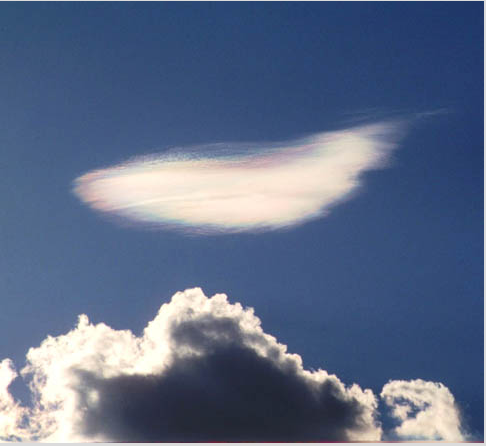Iridescent Clouds
Iridescent Clouds: A Phenomenon of Nature
Iridescent clouds, also known as rainbow clouds, are a mesmerizing atmospheric phenomenon that captivates the observer with their vibrant and ever-changing colors. These ethereal displays of light occur when sunlight interacts with water droplets or ice crystals in the atmosphere, creating a stunning spectacle that seems almost otherworldly. While iridescence can be observed in various types of clouds, it is particularly prominent in lenticular clouds, which are often found in the lee of hills and mountains.
Lenticular clouds, aptly named for their lens-like shape, are formed when air is forced to rise and fall as it is pushed across a mountain or hill. This creates a series of atmospheric waves downwind of the obstacle, with each wave causing an air pocket to rise and expand. As the air ascends, it cools and its water vapor condenses into numerous small droplets. These tiny droplets, suspended within the cloud, act as prisms that scatter and refract sunlight, giving rise to the iridescent colors we observe.
The dynamic nature of lenticular clouds contributes to their ability to produce iridescence. As the air pocket reaches its peak and begins to descend, the compressed air heats up, causing the droplets within the cloud to evaporate. This evaporation marks the end of the cloud, resulting in a distinct boundary between the condensed and evaporated regions. It is along this boundary that iridescence becomes most pronounced, as the changing conditions lead to variations in droplet size and density.
While lenticular clouds provide an ideal environment for iridescence due to their rapidly evolving droplets, other types of clouds can also exhibit this phenomenon under specific atmospheric conditions. For example, altocumulus clouds, composed of water droplets at mid-level altitudes, can occasionally display iridescence when the droplets within them have very short lifespans and limited time to evolve into different sizes. The combination of sunlight, water droplets, and atmospheric dynamics creates a canvas for nature's artistic expression.
It is worth noting that iridescence in clouds is not limited to the visible spectrum of light. Nacreous clouds, also known as polar stratospheric clouds, occur at much higher altitudes in the stratosphere and are primarily composed of ice crystals. These unique clouds can produce iridescence in the ultraviolet range, which is invisible to the human eye but can be captured through specialized imaging techniques. The ethereal beauty of nacreous clouds adds another dimension to the captivating world of atmospheric optics.
In conclusion, iridescent clouds are a testament to the intricate interplay between sunlight, water droplets, and atmospheric dynamics. The phenomenon, most notably observed in lenticular clouds, enchants viewers with its ever-changing colors and dynamic nature. Whether it be the vibrant hues of visible iridescence or the hidden ultraviolet spectra of nacreous clouds, these displays remind us of the awe-inspiring wonders that nature has to offer. So, the next time you gaze upon the sky and witness the mesmerizing dance of iridescent clouds, take a moment to appreciate the magic unfolding before your eyes.


Irisation in Altocumulus Lenticularis - Wave clouds imaged by Chris Grohusko of El Paso Texas.
Lenticular clouds are mostly found in the lee of hills and mountains. They are good sources of iridescence because the droplets in them have very short lives and have no time to evolve into a range of different sizes..
The clouds stay in the same position but air is rushing through them. When air is forced across a mountain it has to rise and then fall again. Under some atmospheric conditions this induces a whole series of waves downwind of the mountain.
An air pocket rising with one of the waves expands as it climbs because the atmospheric pressure falls with height. The adiabatic expansion causes the air to cool and its water vapour condenses into a host of small, fresh droplets. A few instants later the air starts to descend and the downwind edge of the cloud is reached. The air is compressed as it is forced downwards, it heats up and the droplets evaporate - end of cloud.
Lenticular clouds are thus very dynamic objects marking the crests of atmospheric waves and the boundaries of droplet condensation and evaporation.
Nacreous clouds much higher in the stratosphere are also gravity wave clouds.
Note: this article has been automatically converted from the old site and may not appear as intended. You can find the original article here.
Reference Atmospheric Optics
If you use any of the definitions, information, or data presented on Atmospheric Optics, please copy the link or reference below to properly credit us as the reference source. Thank you!
-
<a href="https://atoptics.co.uk/blog/iridescent-clouds-3/">Iridescent Clouds</a>
-
"Iridescent Clouds". Atmospheric Optics. Accessed on December 22, 2024. https://atoptics.co.uk/blog/iridescent-clouds-3/.
-
"Iridescent Clouds". Atmospheric Optics, https://atoptics.co.uk/blog/iridescent-clouds-3/. Accessed 22 December, 2024
-
Iridescent Clouds. Atmospheric Optics. Retrieved from https://atoptics.co.uk/blog/iridescent-clouds-3/.